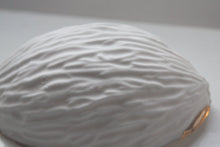
Big walnut shells from stoneware fine bone with blue interior china and real gold
Handmade and very delicate and very strong in stoneware.
Following the sell out of the small walnut shells and after great demand now I have this big walnut shells which have been created with fine bone china and finished with a real gold rim.
Very thin, and light.
They look great as a group and when they rock side to side and touch each other the sound they make is like little bells!
The walnut is so thin and delicate like a small boat and with a gold rim in order to emphasize how precious and delicate some things can be in our life.
8cm x 6cm and 2.5cm high approximately.
As each item is handmade each finish is slightly different.
*please be aware the listing is for one walnut shell only*
*Because of the nature of my work and the material i use it is very unlikely that further copies of this item will be produced in the future.*
Here is a bit about Parian porcelain .
It was named after Paros, a Greek island renowned for its fine-textured, white marble of the same name. It was first made in England in 1846 which succeeded in producing a very perfect imitation of marble, both in surface and in tint. The marble Parian Ware captivated Victorians. It allowed the middle classes to possess articles of high art. And by the end of the 19th Century, every properly furnished Victorian parlor contained at least one piece of it. Victorians welcomed Parian’s inexpensive, small-scale copies of busts of literary and political figures, as well as its decorative vases, boxes and pitchers, adorning their homes with these ornaments to show their gentility. It’s been said that Parian had the same effect on statuary as the invention of the print to painting. Wedgwood named it "Carrara," after the Italian quarry patronized by Michelangelo. But it was Minton which coined the word "Parian" to suggest Paros, the Greek isle that furnished much of the stone used in the classical period. Thus, it quickly became the medium's generic name.









